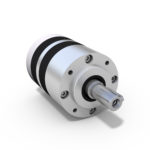Planetary Gearbox
Planetary gearboxes are gear units that are widely used in industrial drive technology due to their compact design and versatile applications. The main difference to other type of gearboxes is the trajectory of the planetary gears. These gears are not mounted in a stationary position, but perform an orbital motion. For this reason, planetary gearboxes are also officially referred to as epicyclic gear units. The colloquial name of a planetary gearbox is derived from the analogy of the orbits of planets in a solar system. Several spur gears run between an externally toothed and an internally toothed gear.
Design and function of planetary gearboxes
The essential parts of a planetary gearbox can be divided into four main components. In the center of the gearbox is the sun gear with external teeth, which is driven by the motor. The power is transmitted to the rotating spur gears, known as planet gears. These are mounted on a planet carrier, which also forms the output shaft and ensures power transmission at the output. The orbit of the planetary gears is limited by a toothed wheel with internal teeth, the so-called ring gear. This usually also forms part of the gear housing.
The number of teeth of the planetary gears can be freely selected in theory, as it has no influence on the overall transmission ratio. They are only responsible for transmitting the torque. Usually, the input and output of planetary gears are arranged coaxially. Due to this and the condition that all gears in mesh must have the same module, the equation for the pitch diameter d=m*z results in the following condition for the number of teeth of the planet gears (please note: number of teeth of the ring gear is always negative).
The number of teeth of the planetary gears thus always corresponds to half the difference between the number of input and output teeth for simple planetary gear units.
The number of planetary gears can vary, but in industrial applications it is at least three. As the number of planetary gears increases, the transmittable torque can be increased by distributing the load over a larger number of tooth meshes.
Characteristics
Since a planetary gearbox contains several planetary gears, several tooth meshes occur at the same time during operation. This power split ensures that, compared to other gear types, a higher efficiency and thus also a higher transmittable torque is possible with a more compact design.
The gear ratio of a planetary gearbox results from the ratio between the ring gear and the sun gear. If the size of the ring gear is kept constant, the ratio can be changed by changing the number of teeth of the sun gear and the planet gears. The smaller you choose the sun gear, the larger the gear ratio will be. For technical reasons, a ratio greater than 10:1 should not be selected, otherwise the number of teeth of the sun gear will be too small. If, however, a higher ratio is required, several planetary gear sets can be arranged in a row in the same ring gear or in two fixed ring gears. This constellation is then called a multi-stage planetary gear.
Planetary gearboxes are suitable for counterclockwise and clockwise rotation as well as for continuous, alternating and intermittent operation.
Advantages of planetary gearboxes
– Compact design
– High torque transmission possible
– High efficiency
– High gear ratios possible
– Coaxial arrangement of input and output shaft
– Wide range of applications
– Two- or three-shaft operation possible for use as a manual gearbox
Applications of planetary gearboxes
Due to the many advantages, the use of planetary gears is not limited to industrial applications; they can be found in many areas. A bicycle with hub gears, for example, is very likely to have a planetary gearbox. In an automatic transmission of motor vehicles, there is also a combination of several planetary gears arranged in series. Other areas of application can be:
– Application in wind turbines
– Application in equipment technology such as robotic mowers
– Drive of cable winches, construction cranes and stirring machines in the construction sector
– Drive of operating tables in medical technology
– In road transport for the operation of barrier systems
Planetary gearboxes are also widely used in industrial applications. Here, the gearboxes are responsible for the conversion of speed and torque in electrical systems and machines. Planetary gearboxes can be attached to any type of electric motor such as servo motor, DC motor or stepper motor. By choosing the right gearbox, the power of the motor and thus the size can be kept as small as possible. Possible areas of application are:
– Drive for machine tables
– Use in conveyor technology for conveyor belts
– Drive for robots


